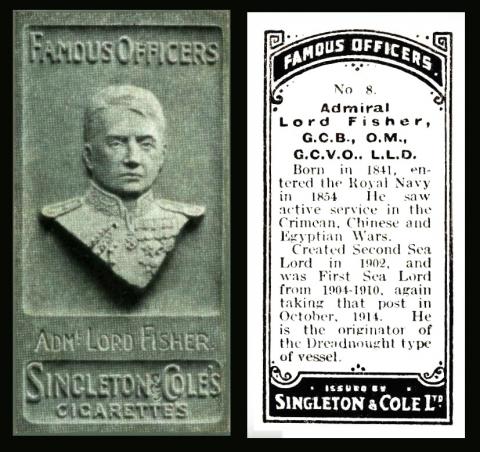
Now here we have Admiral Lord Fisher, and the very last lines of the back text say it all, for it says "He is the originator of the Dreadnought type of vessel".
Admiral Lord Fisher, or John Arbuthnot Fisher, First Baron Fisher was born on the 25th of January 1841. He much preferred being called Jackie or Jacky. He was in the Royal Navy for sixty years, and he is chiefly acknowledged today for his wide ranging reforms to the entire service, from gunnery to ship design and construction, as well as to brand new craft. The Dreadnought was one of his first chances to put these beliefs in to practise before the build rather than to try and retrofit them to an ancient vessel. He had only been First Sea Lord for two years when Dreadnought was launched.
There seems a lot of confusion as to the start date of Singleton and Cole, but we are fairly sure they were established in 1802, which is they date they quote on their sales catalogues. A later date, of 1886, actually the 26th of January, is when they were incorporated, as Singleton and Cole Limited. And then there are three dates in 1897, the 1st of January, from when the profits were diverted into the new company`s account rather than the old one, the 13th of April, when the old firm was officially liquidated, and the 7th of May, which was when their structure was rejigged, simply because they now had more capital, and a lot more property, than the maximum which had been set up in the original incorporation of the company.
They were real people, brothers in law, John Singleton and Joseph Cole, who started out in Wolverhampton, and merged, pretty early on, with another local firm, S. and C. Harries and Son of Shrewsbury, who were also tobacco manufacturers, but whom I cannot track down. However none of the Harries name was retained in the company title, though their Shrewsbury premises were kept. In fact theirs was the only factory in town, and provided most of the employment in the area.
They moved to Birmingham some time in the 1890s, where they occupied a whole block of Cannon Street, number 11 to 16 inclusive. And their telegraphic address was "SINGLETON, BIRMINGHAM". They billed themselves as being "Tobacco, Snuff, Cigar and Cigarette Manufacturers and Importers", but that was just a portion of what they sold, which included pipes, cigar tubes, pouches, smoking cabinets and cases, vesta boxes, ash trays, and shop fittings, including glass shelved display units, mirrors, lanterns, and signs.
In fact we also know that in 1897 Singleton and Cole were the largest of all the tobacco companies within the United Kingdom. Not just that, but they had the largest "Cash with Order" capabilities of anyone in the tobacco trade, and they were also the first to offer the postage of assorted classes of goods in a single parcel. However, in that year, we lose any mention of John Singleton, his name being replaced on all legal documents by a George William Singleton, who had been, for some time, the Manager of the Birmingham branch. It does not say that he was a relative but I presume he must have been. Other new directors have also been added, Henry Charles Clarke, Frederick Simmons, and Charles Paulton Plant - and a secretary, J. Caddick.
By 1908 Mr. Cole was the Chairman and Joint Managing Director with George William Singleton. Frederick Simmons seems to have gone.
Joseph Cole died on November the 24th, 1915, at home in Edgbaston. He was sixty-five years old, and left a widow, three sons, and three daughters. In his obituary it tells that he had started in tobacco when he started working with Cope Bros. & Co., in Liverpool, but I have not been able to track this link yet.
The company was acquired in the mid 1960s by Cavenham Foods, a food processing conglomerate that was started by Sir James Goldsmith in 1964. Within ten years it would be the third largest food processor in Europe, but then it all broke up, and in 1986 it was in voluntary liquidation. The Imperial Group picked it up, and sold the good will, in 2016, to Wilsons & Co. of Sheffield.
This is a lovely set, and the sculptural quality stands out, yet I am sure some readers may find it uninspiring in its greyness.
Our 1956 World Tobacco Issues Index tells us that this set was issued in two versions. Both are small cards, measuring 68 x 36 m/m and they are summarised as "black and white reproductions of busts. Nd. (35)" However it then splits the set into the two versions,
A. titled "Famous Officers"
B. titled "Hero Series", but only cards 1-21 had been seen, not the full set of 35 "Famous Officers"
In our updated World Tobacco Issues Index it still says much the same except it calls them "imitation busts". And oddly there have been no more cards discovered of the "Hero Series", it is static at just cards 1-21
Now there is an oddity because neither of these mention something which appears in the London Cigarette Card Catalogue of 1950. They have the set listed for sale in three versions. The first is A1, "Famous Officers" back, toned card 1915. This is listed as being retailed for between 6/- to 17/6 for odd cards, and £30 for a complete set in that printing. Then they have A2. "Famous Officers" white card, which are listed at between 12/6 and 40/- for odds but not available as a set. It seems very odd that there were enough of the white cards to list them separately, so where did they go and why were they not included in our index? Then lastly they have the "Hero Series", listed at 100/- to 240/- for odd cards, but no sets.
